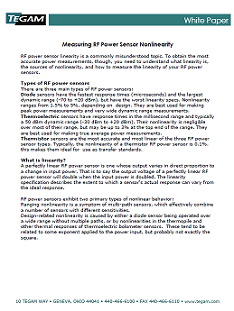
Measuring RF Power Sensor Nonlinearity
RF power sensor linearity is a commonly misunderstood topic. To obtain the most accurate power measurements, though, you need to understand what linearity is, the sources of nonlinearity, and how to measure the linearity of your RF power sensors.
Types of RF power sensors
There are three main types of RF power sensors:
Diode sensors have the fastest response times (microseconds) and the largest dynamic range (-70 to +20 dBm), but have the worst linearity specs. Nonlinearity ranges from 1.5% to 5%, depending on design. They are best used for making peak power measurements and very wide dynamic range measurements.
Thermoelectric sensors have response times in the millisecond range and typically a 50 dBm dynamic range (-30 dBm to +20 dBm). Their nonlinearity is negligible over most of their range, but may be up to 3% at the top end of the range. They are best used for making true average power measurements.
Thermistor sensors are the most accurate and most linear of the three RF power sensor types. Typically, the nonlinearity of a thermistor RF power sensor is 0.1%. this makes them ideal for use as transfer standards.
What is linearity?
A perfectly linear RF power sensor is one whose output varies in direct proportion to a change in input power. That is to say the output voltage of a perfectly linear RF power sensor will double when the input power is doubled. The linearity specification describes the extent to which a sensor's actual response can vary from the ideal response.
RF power sensors exhibit two primary types of nonlinear behavior:
Ranging nonlinearity is a symptom of multi-path sensors, which effectively combine a number of sensors with different sensitivities.
Design-related nonlinearity is caused by either a diode sensor being operated over a wide range without multiple paths, or by nonlinearities in the thermopile and other thermal responses of thermoelectric bolometer sensors. These tend to be related to some exponent applied to the power input, but probably not exactly the square.
Advertisement
Learn more about Tegam





